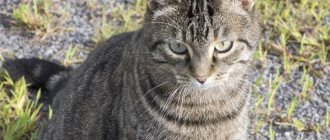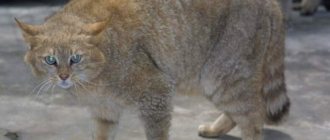History of the Bombay cat breed
The Bombay cat is an artificially bred breed originally from America. In the first half of the 20th century, the American breeder Nikki Horner managed to get a litter from a Burmese cat and an American smooth-haired cat. The woman had experience working with Siamese, Himalayan, Persian and other cats, so she expected that the new hybrid would be similar to a black panther. However, the kittens that were born did not live up to the breeder's expectations, and she continued working.
Contrary to their name, Bombay cats have nothing to do with India.
Three generations of kittens later, Nikki managed to turn her expectations into reality. In 1958, the breeder submitted documents to register a new breed of cats, but experts did not recognize Bombay kittens as representatives of a fundamentally new breed. By 1965, the breeder received new kittens that seemed more “finished.” This time Nikki decided to take her time and carried out a few more matings to make sure that the necessary qualities were consolidated. The breed was recognized in 1970, and 6 years later the Bombay cat became a champion (CFA).
The name of the new breed was given by Nikki Horner herself. The fact is that the black panther (the desired appearance of the new breed) is a type of jaguar or Indian leopard. A gene was discovered in wild animals that is responsible for the manifestation of melanism, that is, animals are born dark-colored. "Bombay cat" is a modified name for the Indian leopard species.
At the moment when Nikki Horner stopped her work on the Bombay breed, black cats received recognition from felinologists and simply lovers of mustachioed animals. The baton of developing the breed was “picked up” by enthusiastic breeders. This group was led by Herb and Suzanne Zwecker. During their breeding work, breeders of Burmese cats lost the right to protest, and Bombay cats began to fully participate in all kinds of championships and shows. One of the cats, Luv It Black, received the title of second best breeding cat (CFA). It was Luv who contributed to the breed being recognized by other authoritative organizations (WCF - World Federation, ACF - Australian Federation, TICA - International Association, ACFA - American Amateur Association).
Back in the 20th century, Bombay cats were recognized by the largest associations of felinologists
At the moment, the breed is still in an active stage of development, breeders are trying to strengthen its best features. But their primary task is to increase the number of representatives of the breed, as well as to popularize beautiful cats with a “wild” appearance. To achieve this goal, it was allowed to cross Bombays with Falcon Burmese and American Shorthair cats.
Application
These anthracite-black beauties are perfect for the role of pets, but only if you are willing to constantly tolerate their presence nearby.
The Bombay cat will not go, like a caracal , to another room, will not jump on the closet and will not doze on the window if the owner is at home. She occupies his lap.
She will decorate your home with her presence.
By the way, some are guided by this very principle - black graceful creatures perfectly set off the Scandinavian style in the interior or serve as a bright living spot in the currently fashionable monochrome style of home decoration.
Although it is still better to choose an animal in accordance with its character.
These anthracite-black beauties are perfect for the role of pets, but only if you are willing to constantly tolerate their presence nearby. The Bombay cat will not go to another room, will not jump on the closet and will not doze on the window if the owner is at home. She occupies his lap
Description of the Bombay cat breed
The breed has two modifications:
- British Bombay cat;
- American Bombay Shorthair.
The British Bombay type was developed by crossing Burmese cats with British Shorthairs, and the American type is a cross between the American Shorthair and the Burmese.
Appearance of Bombays
According to the standard, British-type Bombays can have eyes of both green and golden colors. American Bombays can only have amber eye color (bronze, yellow), and green in this type is considered a defect. Otherwise, these cats are similar: the body is elongated, muscular, small, proportional. The Bombay's head is small, round, with a noticeable stop (curve of the nose). The ears are set wide apart, medium in size, slightly rounded and directed forward. The eyes are large, round, bright in color. The cat's limbs are muscular, of medium length, but slender. The paws themselves are round in shape. The tail is straight, not very long.
The fur of domestic panthers is short, with a hint of shine, perfectly fitting to the body, with a “varnished” effect. The color of such cats is exclusively black. The tip of the nose and paw pads should also be completely black. Even a small inclusion of a different color is a serious deviation from the standard.
Bombay kittens are born with spots, the eye color may be blue, but after a while these external features change, gradually fitting into the standard. Bombay cats are larger than cats (females weigh 3–4 kg, males 5–6 kg). The height of an adult cat at the withers is 25–30 cm.
Photo gallery: Bombay cat in all its glory
Bombays have a graceful figure
Bombay cats have either green or amber eyes.
Bombays are short
Bombays are distinguished by a slightly “sunken” bridge of their nose
Character of black cats
Bombay cats have inherited the best character traits of their ancestors. They are as balanced and sedate as American Shorthairs, but despite this, they are as sociable as Burmese cats. They are very devoted, love their person, have a hard time with separation, and can become sad when alone, so they constantly require attention to themselves. It is better to get such cats for people who can spend a sufficient amount of time at home.
The domestic panther controls itself and does not respond to provocations; it prefers to spend more time at home rather than outside. However, she is quite energetic, active and playful. Children will easily find a common language with a black cat, and the pet will respond with affection and purring, sitting on the lap of its little owner. In addition, she will make friends with another cat if both have to share the love of one person. Bombays are conflict-free, so they get along well with dogs.
Bombay cats have remarkable intelligence, thanks to which they can adapt to almost any proposed conditions. They are also trainable and know how to understand their owner.
Bombay cats can be adopted by families with small children.
Character and behavior
The Bombay cat is a very balanced and peaceful creature. From her ancestors she inherited such traits as restraint, calmness, non-conflict and contact. All family members are her best friends. She does not single out a leader for herself, but on the contrary, she herself strives to take the dominant place in the house, but she does this very gently and unobtrusively.
She is quite a talkative person: her voice is an opportunity to convey her desires to others and share her problems. Females are more “chatty”, and their purring is much more melodic and gentle than that of males.
They get along well both in an apartment and in a private house. They don’t need a lot of space, but their own play corner is desirable. Buy a small play complex with pipes and shelves of different heights - this will be quite enough. In the warm season, it is advisable to take the animal for a walk. If you teach your pet to use a leash from early childhood, you will not have problems in the future.
Name the cat who always wanted to live together
BasilioLeopold
Bombay cats quickly establish contact with other cats and dogs, sometimes even becoming truly friends. But birds and small rodents are prey for them, so don’t be surprised why your cat sits for hours near a cage with a parrot, not taking its eyes off it.
Cats of this breed are lenient towards children: they can tolerate pranks for quite a long time, but at a certain moment they can crack their paws.
Bombays always run to meet guests, but at first they treat them very, very warily: after sniffing their hands, they won’t allow themselves more. And if a person has bad intentions, they will immediately feel it and will behave even more carefully and may show aggression: start hissing at the guest and hiding from him in a secluded corner.
Young Bombay residents are very inquisitive and love to stick their satin nose into all the nooks and crannies of their home, but with age they become more sedate, choosing an observation post somewhere on the windowsill or the back of the sofa, and observing those around them from there.
Buying a Bombay kitten
There are not so many representatives of the Bombay breed. By the way, finding such a nursery in a small town will not be easy. Even if some breeder has a purebred Bombay, the kittens are probably in great demand. And where there is demand, there is a high price. The cost of one kitten depends on its qualities, career prospects, gender and can range from 20 to 120 thousand rubles.
Bombay breeders are sensitive to their “graduates”: their future fate is monitored, and in cases where the kitten was not provided with appropriate conditions, it can be taken back. In some foreign nurseries, purebred kittens are microchipped. The purpose of such a tag is to be able to locate the pet if it gets lost, although some believe that it is necessary to track the individual.
To choose a good kitten for yourself, you will need to take several steps:
- Find a nursery (if you're lucky, in your city).
- Study the breeder's website (conditions for selling kittens, rules, documentation, reviews from former clients, etc.).
- Call the nurseries you like and arrange a visit.
- Go to the breeder and look at the available kittens.
The choice of a kitten must be approached with the utmost seriousness.
How to choose a Bombay kitten
If during a personal visit to the nursery you liked a certain kitten, try to pick it up. He should not bite, scratch or hiss - an aggressive kitten may not be adapted to communicate with people. In some cases, this behavior may mean that his former owners treated him poorly, so he is now afraid of people. In addition, you need to examine the kitten more closely. His nose and eyes should be clean, not "sour", etc. If there is dirt in his ears, he may not be well looked after. The baby should not cough or sneeze. Listen to your breathing - there should be no wheezing.
Look around the area. Cages (beds), bowls of kittens and other animals must be clean. Pets should look healthy, well-groomed and happy. Make sure that the kitten has a litter box (this means that he is already potty trained). Ask the breeder to show the mother cat. She should look healthy, with clear eyes and shiny fur.
When the kitten is chosen, he is favorable towards you, and the price has been agreed upon in advance, you can ask for documents. The breeder must provide the kitten’s veterinary passport with notes on all preventive vaccinations and operations performed, if any, and in cases where the baby’s parents are purebred, also a pedigree.
When I took a kitten from the nursery, the staff themselves offered all the necessary documents. In addition, we were given all the cat's things, as well as souvenirs with his photo. By the way, I heard that the kitten’s things need to be taken with you to the new home.
If you take home an unhealthy cat, it may grow up sick or with behavior problems.
The chosen kitten's coat should be smooth and shiny, like faux fur. There should be no abrasions or wounds underneath. But small scratches on the kitten’s neck are normal, because the mother cat could have injured him, dragging him from one place to another, holding him by the scruff of the neck with his teeth. The presence of insects (fleas, lice, etc.) is unacceptable.
Age of the kitten, when is the best time to adopt it?
By three months, the baby is ready to move away from his wet nurse, because with the cat’s milk he almost no longer receives the antibodies necessary to strengthen the immune system - he will begin to be vaccinated through vaccinations. It is not recommended to take kittens away from their mother before three months, because a sudden change in feeding can lead to intestinal dysfunction. If your baby has already been vaccinated against plague, calcivirosis or rhinotracheitis, this does not mean that he will never get sick from these diseases. You will still need to get a booster shot.
Some veterinarians believe that if a kitten is “forcibly” taken away from its mother, it will suffer severe psychological trauma, and this will subsequently negatively affect social behavior. A cat can push her baby away on her own. This usually happens when the kitten can do without it.
In addition, the cat teaches the kitten to communicate with humans and other animals, visit the litter box, eat from a bowl, etc. - without these skills it will be difficult for him to adapt to adult life. Kittens observe their mother’s behavior and try to imitate her: if the baby sees that the cat is not afraid of humans, then he himself will behave in the same way. For these reasons, it is recommended to adopt kittens no earlier than at least three months. Of course, you want to take a kitten very young and watch how it develops and becomes prettier, but you can wait a month or two.
Kittens should not be separated from their mother too early - this can negatively affect their health and subsequent development.
How to choose?
Bombay cats are considered quite rare representatives of their species. Not in every city you can find a nursery that sells these animals. Therefore, they are in high demand in the market among pet lovers. It is worth considering that under such conditions the cost of cats will be high. The price depends on the gender, age, qualities of the pet and its prospects.
In order to choose a good pet, you need to go through several stages:
- find the necessary nursery;
- study detailed information about the nursery and the Bombay breed;
- pre-arrange a meeting with the breeder;
- go to the nursery and choose a cat.
Once you have chosen the right kitten, it is recommended that you pick it up. This way you can find out the animal’s character and health status. Bombay should not scratch or bite, this shows his aggressive attitude. Such kittens will take a long time to adapt to new conditions and communication with household members. If the pet has already had owners, then this behavior indicates a rude attitude towards it, which provoked fear of new people.
You should carefully examine the Bombay black cat. The ears should be clean, the same goes for the nose. Be sure to check the animal’s eyes; there should be no “nitrous” in them; their presence may indicate poor health of the cat. The pet's coat should be smooth and shiny. No wounds on the body are allowed. An exception may be scratches on the animal's neck. Usually such damage is left by mother cats after dragging a kitten. Don't forget to inspect the animal for various insects.
Be sure to pay attention to the kitten's breathing. It should be clean, without any wheezing
When choosing a pet, you also need to pay attention to the living conditions of the animal. The enclosure must be clean. The same applies to the animals themselves. If kittens have a litter box, they are most likely already potty trained. Before buying a Bombay kitten, it is advisable to look at the mother cat. She should not look sickly, her coat should be shiny, and her eyes should be rich in color and clear.
When the choice is made, you need to negotiate the cost of the pet, and then proceed to inspect its documents. An animal passport must be available, which contains information about vaccinations and diseases. The passport also contains information about operations, if any.
Features of keeping Bombay cats
Bombays are real homebodies, they are much more comfortable at home than on the street, so it is not necessary to walk such cats, but if it so happened that you had to go outside with her, then you need to do this with a harness or leash. The animal may become frightened, panic and run away. The cat will not be able to hide under a nearby bush; it will definitely climb somewhere (for example, onto a tree), and to remove it will require some effort.
However, the cat will still need physical activity, so you should make sure in advance that the house has everything necessary for the proper development of the pet. The following things are required:
- house or bed;
- 2 food bowls and 1 water bowl;
- tray (small at first, then can be replaced with a larger size);
- filler (for kittens or universal for small animals);
- toys;
- scratching post and/or nail clipper;
- brush with natural bristles;
- special shampoos and conditioners for cats.
Some save on buying gaming complexes, because it is believed that they take up too much space. I made a small wall set for my cat. It doesn’t take up much space and costs a penny: I cleared out the bookshelves, connected them together with a scarf, just showed the cat once how to use this structure, and now this is her favorite place.
Pet food
Bombays have a wonderful appetite and can eat all day long. Even if the pet is full, it will resort to various tricks just to be fed again. Males of the Bombay breed are prone to obesity, so the owner of a black cat will have to regulate the amount of the cat's diet. They cannot be given food from the master's table. When feeding naturally, you need to remember the same balance of microelements and nutrients. Usually the menu is made up of pure products:
- lean meat;
- vegetables fruits;
- cereals (buckwheat, rice, oats, etc.);
- fermented milk products (unsweetened yogurt, kefir, etc.);
- specially grown grass for cats or sprouted oats.
For a cat to grow active and strong, it needs to be fed properly.
Kittens are fed 3-4 times a day, and adult cats - 2 times a day. It is advisable to feed your pet at the same time every day. A cat's body can get used to a clear schedule. It is not recommended to combine natural food and ready-made food - dry food is already balanced in accordance with the needs of the animals. Between feedings, you can occasionally give fresh lean meat (frozen or boiled). If the main diet consists of dry food, then this should be the best food you can buy.
Cats are strictly prohibited from eating anything spicy, smoked, salty or sweet. But I occasionally give my cat a quarter of candy. She usually begs for chocolate, but I'm afraid of allergies, so I give her simple fudge or butterscotch. Our veterinarian scolds me for this, he says that sweets are harmful to the animal’s teeth, but when she asks so pitifully, I am unable to refuse her.
Appearance care
Bombays may have watery eyes (this is due to physiological characteristics), so you need to remove the discharge daily with a cotton swab or a piece of cotton wool dipped in tea or distilled water. You need to clean your pet’s ears in the same way (once a week), but instead of tea, Vaseline or special oil is usually used. The animal's teeth are cleaned only with a special toothpaste using a small toothbrush (1-2 times a month).
Domestic cats take care of the hygiene of their claws themselves. For this they have a scratching post. But this does not mean that there is no need to trim your nails. The tip of the claw will be sharp even after a scratching post, and this promises scratches on the owner, furniture and walls. It is these ends that need to be cut off (1–2 millimeters). To do this you must have a nail clipper. If you yourself are afraid to carry out this procedure, or the cat protests, then you can turn to professionals (grooming masters).
How to comb and bathe a Bombay
The appearance of any purebred cat requires careful care.
Bombay cats have short and smooth hair, so they do not need complex treatments using a lot of brushing. To comb such a pet, a rubber massage mitten will be enough. During the molting period, you can brush your cat’s hair with a brush with soft bristles - it will be pleasant for her. You can bathe your cat once a month; for this you need a special shampoo for animals. You cannot wash your cat with human shampoo.
When my cat first came into the house, she was terribly afraid of water. I gradually introduced her to water. By the way, when you put a small towel (rubber mat, rag) on the bottom of the basin, cats are not so afraid, because their paws feel the bottom. At first I poured a little water (3-5 centimeters), in which she simply wet her hind paws, convulsively grabbing my neck with her front paws. Gradually I increased the volume of water. Now the cat sits calmly even in the bath. My cat has 2 requirements: the water level should be a maximum of 15–20 centimeters from the bottom, and its temperature should be comfortable. We don’t have such a thermometer, so I check it as follows: I put my hand in the water (about up to the elbow), “listen” to the sensations in the wrist area. If the water is hotter than I usually pour for myself, it means the cat won’t freeze. But the water should not be very hot.
Cats' fur is covered with natural oil, so they are not bathed too often - usually veterinarians advise performing water procedures only if the cat has soiled itself with something difficult to wash off (oil, gasoline, etc.). But on black cats such dirt is difficult to “calculate”, so the degree of dirtiness can be determined by smell or tactile sensations (dirty fur can stick together).
Catering
Bombays love to eat and lick their bowls until they shine. But too much food will turn from an elegant and graceful animal into a clumsy bun, suffering from shortness of breath, palpitations, diabetes, or worse. Therefore, remember the following:
- The cat must not be overfed! Adult animals (over six months old) eat 2 times a day: morning and evening. An exception can be made for lactating and pregnant females, sick or elderly animals. Teenagers 4-6 months eat 3-4 times, babies – 5-6.
- The animal should be switched to a new food gradually, and not suddenly change the diet. Apart from indigestion, this will not bring any benefit.
- You cannot mix natural food and ready-made food: choose one.
- Your cat should have separate bowls for water and food. It is advisable to wash the dishes after each meal so that they do not stagnate and become saturated with an unpleasant odor.
- Be sure to clean drinking water from harmful impurities and chlorine. A regular faucet filter will help with this. Or you can leave the liquid in a jar without a lid for 8-12 hours in a dark place.
Natural products
The following natural products are allowed:
- Meat. Only low-fat varieties: rabbit, turkey, veal, beef. The meat is pre-frozen, and before feeding it is thawed and doused with boiling water to destroy possible parasites. They feed the meat every day, cutting it into pieces 1-2 cm long. Fat layers, bones, and skin are removed. The exception is chicken necks: they are ground into minced meat along with cartilage.
- Fish. Salmon families: chum salmon, pink salmon, salmon, river trout. Or lean (if the cat is on a diet): blue whiting, cod, hake. All sharp parts, bones and fins must first be removed. It is also undesirable to give heads and milk. The fish is boiled for at least 20 minutes in unsalted water and given once a week. More often it is impossible - excess fish leads to the development of urolithiasis.
- By-products. This is an additional source of minerals and vitamins. Liver, hearts, ventricles - boiled or raw.
- Dairy products. Low-fat cottage cheese, natural yogurt without dyes and other additives, kefir, fermented baked milk, yogurt, low-fat sour cream.
- Eggs. Chicken ones are boiled and only the yolk is given to the cat (the protein gives the cat diarrhea), quail ones are fed whole.
- Porridge. Buckwheat, rice, oatmeal, barley. Porridge can be included in the diet when the kitten is 1.5 months old: first they are cooked in milk, and then in vegetable or meat broth. You can feed porridge every other day in the proportion of one part porridge to 3 parts meat.
- Vegetables. No more than 10% of the daily food intake. Zucchini, carrots, broccoli, asparagus, green beans, celery, beets. You can’t give them raw ones – the cat might choke! The exception is cucumbers and melons. They perfectly quench thirst. The hard skin can be removed.
It is prohibited to give:
- Pork and pork by-products (contains histamines), goose, duck and lamb (poorly digested), fresh liver and raw lung (causes diarrhea and vomiting), minced meat from the store (it often contains skin and fat);
- Corn, pea, millet porridge, semolina (it is acceptable to feed babies liquid semolina porridge with milk), instant porridge;
- Avocado, garlic, onions, grapes, raisins (and dried fruits). Potatoes cause constipation, so you should be careful with them;
- Sweet, smoked, salty, flour, baked goods;
- Dog food;
- Human vitamins;
- Tea, coffee, cocoa, whole cow's milk, mineral and sparkling water, juices, compotes.
Recommended food
Among industrial feeds, holistic and super-premium class feeds are considered the best. These are Fitmin Purity, Go Natural, Arden Grange. The rest - food from the economy and premium groups - are made from meat waste (rather than pure meat), contain chemical preservatives, dyes and flavor enhancers, which, naturally, will not benefit the cat.
| Holistic | Holistic | Super premium |
| Canagan | Gather | Bozita |
Vices of Bombay cats
Any purebred cat can have defects
Since the Bombay breed is quite young, felinologists have not yet learned to avoid hereditary defects. Physiological defects of Bombays can affect the cardiovascular system, spinal canal, and skull structure. So, a Bombay may have a “Burmese craniofacial defect”. This disorder manifests itself in kittens even in the womb. Babies are born with a severe deformation of the skull, so they are killed immediately after birth - the deformation of the skull will still lead to death. In addition, Bombay cats may have breathing problems - according to felinologists, this is due to the special structure of the foot.
Another common problem in Bombays is watery eyes, which most often occurs due to conjunctivitis. In such cases, the owner can cure his pet himself (using a tea solution), but sometimes you can contact a veterinarian. Veterinarians prescribe medication depending on the degree of neglect: tetracycline ointment (to be applied behind the eyelid) or eye drops (usually those prescribed to people). Conjunctivitis takes a long time to cure (sometimes up to two weeks). In any case, self-medication is contraindicated here, because lacrimation may indicate the onset of a more serious illness.
And these panthers may also have gum inflammation. It is difficult to detect such a sore at an early stage, since the animal’s teeth may always appear white and healthy. The inflammatory process itself usually leads to tooth loss. The disease can be recognized by loss of appetite. Oral antiseptics are usually prescribed for treatment.
Donut (my sister's cat) once had sore gums. The teeth themselves seemed white, but the cat stopped eating, lay there for two days with a pitiful look and practically did not get up. The sister decided that he had eaten something wrong, which is why his stomach hurts and he has no appetite. On the third day, Donut was taken to the vet. The veterinarian immediately determined that it was an inflammatory process and prescribed some kind of spray (and something else). Since diet affects the quality of teeth, he wrote a feeding recommendation.
Any hereditary Bombay disease can lead to serious consequences
Another disease common to many breeds is a genetic predisposition to hypertrophic cardiomyopathy. This disease usually results in thickening of the walls of the ventricles of the heart. Because of this, myocardial function is disrupted and heart failure occurs. Cardiomyopathy can only be cured with medication, and treatment in the early stages will be most effective. It is worth making annual examination visits to the veterinarian for preventive purposes. Treatment usually includes beta blockers, diuretics, and drugs to prevent thromboembolism.
If the owner of a Bombay cat takes care of his pet, then the animal will delight his person for a couple of decades. The normal life expectancy of the breed is 18–20 years.
Bombay cats have a number of external deviations from the standards. Sometimes such defects lead to disqualification or exclusion of the animal from participation in the championship (exhibition, show):
- presence of marks or stains;
- the nose and paw pads are not black;
- green eyes or excessively pronounced stop, leading to difficulty breathing or wheezing;
- malocclusion;
- incorrect number of fingers;
- tail defects;
- heavy body or weak muscles.
Video: healthy Bombay cats
Health
Bombays have fairly good health and can live up to 20 years. But, unfortunately, the Bombay cat is not native and, like all artificially bred cats, has a number of genetic diseases.
Burmese craniofacial defect
This genetic disease was discovered in the last century. It is caused by a recessive gene that affects the cat's head formation gene and leads to irreversible mutations of the skull and muzzle. It is called Burmese because it is most common among cats of the Burmese breed and their descendants (including Bombays).
The severity of the disease depends on how many copies of the mutated gene there are in the animal's genome. If there is only one copy, the defect is expressed in brachycephaly (short head syndrome). But if there are two copies, then the disease develops into much more serious damage: the syndrome manifests itself in full and causes mutations incompatible with life. Among them are an unformed skull and a bifurcated upper jaw.
Brachycephaly is one of the manifestations of BHD
This genetic disease appeared “thanks” to the efforts of breeders of the Burmese breed. They tried so hard to breed a cat with a perfectly round head that they created a new mutation. In the West it is called BHD. Among the Burmese breed, this disease is an acute problem, especially among American Burmese.
Nowadays, a special DNA test has been developed that detects the presence of a Burmese craniofacial defect in the genome of a cat. BHD only appears if both parents of the offspring are carriers, so the test is very important for breeding work. It is recommended that carrier animals be excluded from breeding, but not all breeders heed this recommendation.
Hypertrophic cardiomyopathy
The disease consists of thickening of the walls of the ventricles of the heart. This makes it more difficult for the muscles to contract, which can lead to a deterioration in your pet's well-being. Diagnosed using ultrasound.
Symptoms of pathology:
- severe shortness of breath;
- tachycardia;
- a significant increase in sleep time;
- bluish color of mucous membranes;
- wheezing, heavy breathing;
- fainting.
The disease can be hidden, without obvious symptoms. Therefore, the animal must be shown to the veterinarian regularly. Fortunately, if detected early, hypertrophic cardiomyopathy can be cured.
Hypertrophic cardiomyopathy is difficult to diagnose, so you need to take your cat to the veterinarian as often as possible so that he can notice the slightest changes
Labored breathing
This disease of Bombay cats has several causes:
- nasal flexure mutations;
- brachycephaly;
- runny nose.
As a rule, in the first two cases it will be impossible to help the cat. But a runny nose usually appears against the background of other problems:
- Fungi, bacteria.
- Viruses.
- Allergy.
- Chronic illnesses.
- Ear inflammation.
- Hypothermia.
- Neoplasms.
- Foreign bodies, irritants.
- Congenital pathologies.
- Parasites.
Treatment is prescribed by the veterinarian according to the cause.
Breeding the Bombay breed
The first heat of Bombay cats occurs at 6–8 months and lasts about a week. If the cat does not become pregnant during this period, then in a couple of weeks the heat will repeat. However, professional breeders are in no hurry to produce offspring, so the first mating of the pet is carried out when the cat has reached one year. Bombays are a little lazy in terms of breeding, so you need to be able to choose the right time, usually this is the second - fourth day of estrus.
If the owner has decided that the cat must give birth and will not be sterilized, all that remains is to select the right cat. Now there are many different nurseries, finding them will not be difficult, since most professional breeders have their own websites and blogs. But it’s not enough just to find a cat of the same breed; it must suit your cat.
Breeding Bombay cats is an art
How to choose a partner
The owner of a black panther must first decide whether he wants to continue the family of a purebred pet or simply fulfill the animal’s vital needs. After all, in the second case we are not talking about finding the “ideal groom”. The difficulty may lie in preserving the genetic data of the breed. In such cases, you need to look for professionals. An experienced breeder, as a rule, has a client base, so finding out the opinions of other cat breeders about the chosen cattery is not so difficult. The more former clients a breeder has, the more experience he has.
If it turns out that the selected breeder has a suitable cat, you need to visit the nursery premises. This could be the breeder's apartment (this is good, since domestic cats are healthier) or a work area where other animals are kept. It is necessary to inspect the territory, living conditions and appearance of the pets. If the cages are clean and the animals look neat, it means they have been well cared for and are healthy. Particular attention should be paid to the cat’s appearance: the coat should be shiny, the eyes should be clean, and the teeth should be white.
You can ask the breeder for the cat's pedigree. If it is, the animal's parents are also purebred. The more ancestors of an animal are known, the better, because in the Bombay breed there is a possibility of kittens being born with defects incompatible with life. Therefore, you need to be sure that there have never been such litters in the cat’s family. You can also look at the male's parents. Their appearance will make it clear who their grandchildren might look like.
The success of mating depends half on the right choice of partner for the cat.
At what age should a Bombay be given for first mating?
Less experienced owners of Bombay cats give their pets for mating from six months (with the first heat). Pregnancy does not occur and a number of questions arise: why did this happen, is the cat to blame, how to fix it. It is important to remember that Bombays are practically indifferent to the opposite sex, therefore, even if you give your panther under the age of one year for mating, at least let the cat be experienced.
The ideal age for the first mating is from one to one and a half years. At this age, the cat’s body is already fully formed and ready to bear healthy offspring.
Veterinarians recommend giving the cat a rest between births: although whiskered animals can breed several times a year, experienced breeders breed their Bombays only once during this period. During the breaks, the mother's body must recover and gain strength - often the giving birth cat will weaken, become thin, and her immunity will fail.
Owners' opinion about the breed
In general, Bombay cat owners leave very positive reviews of this breed. Owners of miniature panthers note that they are very clean, smart, affectionate and strongly attached to all family members. The happy owners do not note any shortcomings. The only negative is the unusually high price of a purebred kitten.
However, do not forget that not everything may be so rosy. Bombay is definitely not suitable for those people who prefer peace and quiet. The animal loves to meow loudly and have fun in every possible way, especially with the participation of the owner. You will also have to carefully monitor your diet and regularly visit the veterinarian, not to mention the high price.
If the shortcomings of the breed do not frighten you and you want to have a miniature black panther at home, then you can safely get a Bombay cat. She will perfectly complement the exotic interior of the apartment, become a devoted friend and bring joy to the whole family.
Castration and sterilization of Bombay cats
Castration is an operation to remove the sex glands. Sterilization involves only ligation of the fallopian tubes - the production of hormones will continue, and sexual desire will remain. Therefore, if the owners’ plans do not include reproduction, it would be more humane not to sterilize, but to castrate the animal - in this case, the pet will be insured against the possible development of ailments of the reproductive system, will become calmer and more balanced, and its quality of life will increase.
If a cat is not supposed to give birth, then she needs to be neutered.
If a cat is not bred, but she is in heat, she may get sick. Abstinence in cats usually leads to gynecological diseases (including uterine cancer). If you plan to remove only the ovaries, it is best to castrate the animal before the first heat and signs of sexual desire appear - in the future, this will almost completely eliminate the risk of developing uterine cancer.
Such operations are carried out in animal clinics where there is a veterinary surgeon. The pet is brought in in advance (the day before), he is not fed (not required before the operation), but he is observed and the necessary tests are taken. The surgery itself takes place under general or local anesthesia. Local anesthesia is usually sufficient for cats, but the surgery performed on a cat is abdominal, requiring general anesthesia.
We didn’t wait for the guy’s hormones to start raging. At seven months they took him for castration. He tolerated the operation well. It was a bit difficult to recover from anesthesia: there was weakness and drowsiness. But within a day he was again rushing around the house like a hurricane.
perfectionist, forum user
https://otzovik.com/review_1194188.html
I sterilize all my cats because they are always outbred. I wait until the cat is one year old and start looking for a clinic. I spayed my last cat when she was one and a half years old. The operation itself took about ten minutes, but the most difficult thing was the care after the procedure. The cat recovered from anesthesia for almost a day.
Video: how to care for your pet after surgery
Table: pros and cons of the Bombay breed
| Criterion | Positive sides | Negative sides |
| Appearance | Beautiful appearance of a miniature panther, shiny, soft fur, bright eyes | Due to the special structure of the facial part of the skull, there may be health problems |
| Character | An affectionate cat that loves its owner and is friendly with children and other animals. | — |
| Habits and Habits | Amenable to training, remembers gestures and facial expressions of the owner | Can be cunning when asking for food supplements |
| Content Features | Able to adapt to any new conditions, no need to comb or bathe | If you take care of your appearance improperly, a number of problems can arise (sniffling, tearing, inflammation of the gums) |
| Health | Has good immunity and with proper care can live up to 20 years | There is a predisposition to serious illnesses |
| Breeding | Cats give birth on their own and cope without human help. | There is a risk of giving birth to kittens with serious defects in the structure of the skull |
| Reviews | The vast majority of owners are satisfied with the cat's character | — |











